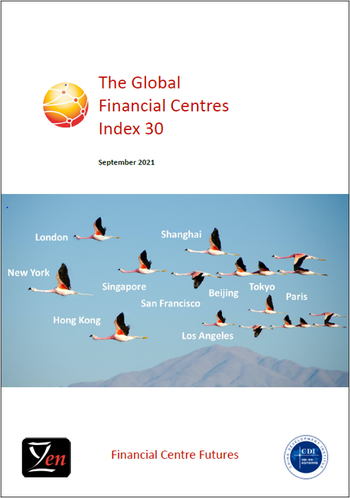Authors
Mike Wardle & Professor Michael Mainelli
Published by
Long Finance & Financial Centre Futures (September 2021), 63 pages. Produced by Z/Yen in Partnership with CDI.
Share on social media:
The Global Financial Centres Index 30
The thirtieth edition of the Global Financial Centres Index (GFCI 30) was published on 24 September 2021. GFCI 30 provides evaluations of future competitiveness and rankings for 116 financial centres around the world. The GFCI serves as a valuable reference for policy and investment decision-makers.
China Development Institute (CDI) in Shenzhen and Z/Yen Partners in London collaborate in producing the GFCI. The GFCI is updated and published every March and September, and receives considerable attention from the global financial community.
126 financial centres were researched for GFCI 29 of which 116 are now in the main index. The GFCI is compiled using 146 instrumental factors. These quantitative measures are provided by third parties including the World Bank, the Economist Intelligence Unit, the OECD and the United Nations.
The instrumental factors are combined with financial centre assessments provided by respondents to the GFCI online questionnaire. GFCI 30 uses 77,391 assessments from 12,862 respondents.
The results of GFCI 30 include:
- Among the top 40 centres, only two fell more than 10 rank places, and six rose more than 10 places.
- Overall the average rating fell 12.9 points (2.05%). While a small change, this is the third consecutive fall in the average rating.
- These factors suggest that there remains some lack of confidence in the world economy. The fact that overall ratings continue to fall against the levels that we saw in 2019 reflects the continuing uncertainty around international trade, the impact of the covid-19 pandemic, and geopolitical and local unrest.
- Asia/Pacific centres generally fell in the ratings in GFCI 30, and assessments from people based in Asia/Pacific suggest that they judge Chinese centres in particular less favourably than before. This might suggest that the economic gains in the region arising from covid-19 may be levelling off.
- North American centres performed well in GFCI 30. This is likely to reflect renewed optimism about the US and Canadian economies as they move forward from the pandemic.
- The relatively strong performance of New York and London suggests that the financial services sectors in these cities managed to sustain their performance despite radical changes in working practices during the last 18 months.
Leading Centres
- New York leads the ranking, with London second. Both centres fell only slightly in the ratings.
- Hong Kong and Singapore in third and fourth positions fell 25 points in the ratings.
- San Francisco, Los Angeles, and Paris entered the top 10 in GFCI 30, with falls in the ratings and rankings for other leading Asian centres.
- Nine of the top 10 centres in the index fell in the ratings.
Western Europe
- London continues to lead in the region, dropping only three points in the ratings. This reflects confidence in the longer-term prospects for the centre.
- Other leading Western European centres had mixed results, with Paris, Amsterdam, Madrid, Stockholm, Hamburg, and Munich moving up the rankings while Frankfurt, Zurich, Edinburgh, Luxembourg, Stuttgart, and Brussels fell back, as centres compete following Brexit.
Asia/Pacific
- The majority of the Asia/Pacific centres in the index fell in the rankings in GFCI 30. The exceptions were Hong Kong, Singapore, Seoul, Busan, Wellington, Qingdao, Mumbai, New Delhi, Bangkok, GIFT City-Gujarat, and Jakarta.
- This reflects the strong performance of other regions, and may also reflect a levelling off following the good economic performance of the region through the pandemic.
- Each of the Asia/Pacific centres in the top 10 in the GFCI dropped 25 points or more in the ratings.
North America
- North American centres performed strongly, with eight of the 11 centres in the region either maintaining or improving their ranking.
- Seven North American centres now feature in the top 20.
- Most centres saw a drop in their ratings, although these were not as sharp as in some other regions, enabling the rank improvements shown for the region.
Eastern Europe & Central Asia
- Moscow, Warsaw and Istanbul lead in the region, which also performed strongly.
- 12 of the 16 centres in the region rose in the GFCI rankings and nine centres improved their rating.
- Many economies in the region are forecast to recover strongly following the shock of 2020.
Middle East & Africa
- Dubai and Abu Dhabi take first and second places in the region, both improving in the ranking slightly.
- Casablanca continues to be the leading African centre, while Cape Town, Johannesburg, and Nairobi increased their ratings by more than 20 points.
- Kigali and Lagos join the index for the first time.
Latin America & The Caribbean
- Mexico City, Rio de Janeiro, and Sao Paulo were the only centres in the region to improve their ranking and ratings.
- Other centres, including the Caribbean islands, fell sharply in the ratings, reflecting the economic shock experienced in the region as a result of the covid-19 pandemic.
FinTech
We are able to rate 109 centres on their Fintech offering.
- Fintech ratings were generally lower than in previous editions of the index.
- New York and Shanghai retained first and second positions, with London rising two places to third place.
- In the top 40 positions, Western European centres performed well, with most gaining rank position.




